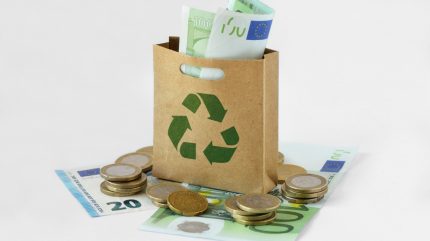
Sustainable packaging is no longer a niche concern; it has become a mainstream priority as consumers, regulators, and brands seek solutions to the mounting plastic waste crisis.
As sustainability in packaging grows more urgent, investors and packaging companies are increasingly focused on four key areas that promise both environmental benefits and long-term business opportunities:

Discover B2B Marketing That Performs
Combine business intelligence and editorial excellence to reach engaged professionals across 36 leading media platforms.
improving recyclability, expanding the use of recycled content, advancing compostable materials, and developing reusable systems. These four paths are at the heart of the hottest investment themes reshaping the future of eco packaging.
Improving recyclability through material innovation
Enhancing recyclability remains a cornerstone of sustainable packaging. Many everyday packages still rely on multi-layer plastics and composite materials that are difficult, if not impossible, to recycle with existing infrastructure.
This challenge has spurred a wave of investment into mono-material solutions—packages made entirely from one type of plastic or paper, making them easier to sort, process, and reintroduce into the manufacturing cycle.
In parallel, fibre-based packaging alternatives are gaining traction as brands look to replace traditional plastics with renewable materials like moulded pulp, cartonboard, or paper-based laminates.

US Tariffs are shifting - will you react or anticipate?
Don’t let policy changes catch you off guard. Stay proactive with real-time data and expert analysis.
By GlobalDataInnovations such as water-based barrier coatings allow these materials to maintain protective qualities while remaining compatible with recycling systems.
These advances are key to meeting the growing consumer demand for recyclable packaging, which now influences purchase decisions across markets from Europe to Asia.
For investors and packaging companies alike, prioritising recyclable design supports compliance with emerging extended producer responsibility (EPR) regulations, helping brands avoid penalties while building consumer trust.
Scaling recycled content to close the loop
Integrating recycled content into packaging has emerged as a powerful tool for reducing reliance on virgin materials and lowering the carbon footprint of packaging production.
Yet, despite pledges from major consumer goods companies to increase recycled content, the supply of high-quality, food-grade recycled plastics remains insufficient to meet demand.
This imbalance has created a significant investment opportunity: improving collection systems, expanding sorting capacity, and developing advanced recycling technologies such as chemical recycling to boost the availability of recycled feedstocks.
Recycled polyethylene terephthalate (rPET) and recycled polyethylene (rPE) are particularly in focus, given their widespread use in bottles, films, and flexible packaging.
Beyond environmental benefits, incorporating recycled content can offer brands a market edge as sustainability becomes a key differentiator.
For packaging converters and material suppliers, investing in recycling infrastructure and establishing reliable, traceable supply chains for recycled materials are crucial steps in advancing the circular economy.
By scaling recycled content, the packaging industry moves closer to achieving true material circularity.
Advancing compostable and biodegradable solutions
Compostable packaging offers an appealing solution for reducing the environmental impact of packaging waste, particularly for foodservice items and flexible films that are often contaminated with food residues, making them unsuitable for recycling.
Recent innovations in bio-based polymers, such as polylactic acid (PLA) and polyhydroxyalkanoates (PHAs), have broadened the performance and application range of compostable materials, creating products that can degrade under industrial or even home composting conditions.
However, success in this area hinges on aligning packaging design with local waste management capabilities. Without proper composting infrastructure and clear labelling to inform consumers, compostable packaging risks ending up in landfill or contaminating recycling streams.
Investment opportunities lie not only in developing new compostable materials but also in building regional composting facilities and creating robust certification and labelling schemes.
When supported by the right systems, compostable packaging can help divert organic waste from landfill, enrich soil health, and provide a sustainable alternative where recycling is impractical.
Developing reusable packaging systems
Reusable packaging systems represent a transformative shift away from single-use culture. By creating durable containers designed for multiple uses, brands and retailers can dramatically reduce packaging waste, lower lifecycle emissions, and appeal to environmentally conscious consumers.
From returnable glass bottles to reusable e-commerce delivery totes, these systems are gaining momentum as part of broader zero-waste initiatives.
Successful implementation of reuse models depends on convenient collection, efficient cleaning processes, and consumer incentives. Companies such as Loop and Algramo have demonstrated that well-designed reuse systems can thrive in both online and brick-and-mortar retail settings.
Investment opportunities exist across the entire value chain: technology platforms for tracking and managing reusable assets, reverse logistics networks to return packaging, and hygienic washing and refurbishment operations.
As cities and governments introduce reuse targets and bans on certain single-use items, reusable packaging stands poised for significant growth.
Final thoughts on the future of eco packaging
The four paths—improving recyclability, scaling recycled content, advancing compostables, and developing reuse systems—offer clear, actionable routes for businesses and investors looking to lead in sustainable packaging.
Each approach comes with unique challenges, from technical barriers to infrastructure needs, but they also present opportunities to differentiate, meet evolving regulations, and respond to consumer expectations for greener products.
Brands that embrace these investment themes can build resilience against tightening environmental policies, strengthen their market positions, and contribute meaningfully to a circular economy.
As eco packaging continues to evolve, these strategies will remain vital to cutting packaging waste and protecting our environment for the long term.





